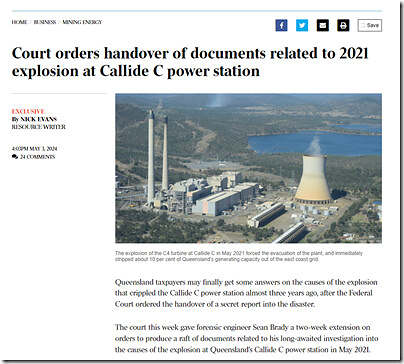I was on the road last week (including for the EUAA National Conference, as noted here) but noted more media articles in the Australian about the long-running saga of ‘the Brady Report’ following investigations into the technical causes of the Callide C4 Catastrophe.
(A) Media articles about the Court Case
Here’s a quick wrap…
(A1) In the Australian
On Friday 3rd May 2024, Nick Evans wrote ‘Court orders handover of documents related to 2021 explosion at Callide C power station’ in the Australian:
… so at that time we expected to see the report released during May 2024 (the article contains other details worth reading, for those who have access).
But yesterday (Tuesday 7th May) we saw Nick Evans and Angelica Snowden provide the update ‘State-owned CS Energy wants the federal court to keep Callide C explosion report secret’ in the Australian:
So I guess we have to wait, to see what the Court rules?
(A2) At the Federal Court
Remember that there are a couple different matters related to Callide C4 in the Federal Court at present:
QUD61/2024 … by Sev.En (part owner of part owner)
In several articles we’ve highlighted updates on the Court Case referred to in Nick’s articles above … most recently on 29th January 2024 with ‘Federal Court rules about Callide C – independent investigation authorised’.
In this case the Federal Court website reference is here (docket number QUD541/2023).
QUD61/2024 … by the AER
On 9th February 2024 we wrote ‘The matter of Callide C back in Federal Court (this time via AER)’ … and that the relevant reference Number appears to be QUD61/2024.
(A3) With the stakeholders
With respect to the key stakeholders:
(a) At CS Energy
I could not see anything on the news section of the CS Energy website … nor did I see any updates here on the company profile LinkedIn.
(b) At Sev.en Global Investments
I also did not see anything under ‘Press Releases’ or ‘News Highlights’ on the 7GI website.
(A4) Elsewhere?
I’ve not looked specifically, but have not seen anything else.
(B) 53 days till return to service?
Whilst publishing this article, worth attaching the latest snapshot from the ‘Forecast Convergence’ widget in ez2view to highlight that there’s been no recent change in return-to-service expectations:
Remember that this widget allows the user to ‘look up a vertical’ in order to see ‘that other dimension of time’
We are still looking at:
1) Return to service at part load (i.e. 210MW) on Sunday 30th June 2024
2) Full service (i.e. back to 420MW) on 31st July 2024.
Given that the turbine and generator (and associated plant) are all new, and that the boiler has been in deep storage for ~3 years (presumably nitrogen capped or something similar*) it will be with keen interest to see how smooth the return to service operations are.
* for those unaware, this type of process was used at other times in the NEM, such as when some Tarong units were mothballed ~10 years ago.
Stay tuned…





This is what happened at Callide C4. They tried to re-invent the wheel! It was ignorance. Just remember ignorance is just the lack of knowledge. Large 220 VDC Batteries are not designed to be connected together under loaded conditions because of the large fault currents produced when used for large critical loads in a power station. We are lucky it was only a coal fired power station
Indeed, the modification of the Callide C4 design, which included the removal of the Castell key interlocks, unfortunately led to a catastrophic failure. The attempt to improve the system’s redundancy and reliability inadvertently resulted in the complete destruction of the steam turbine, incurring significant costs.
The incident underscores the importance of thorough risk assessment and testing when implementing design changes, especially in critical infrastructure like power plants. It’s a stark reminder that while innovation and improvement are necessary, they must be approached with caution to ensure safety and reliability are not compromised.
The lessons learned from the Callide C4 incident will undoubtedly contribute to safer and more reliable design practices in the future. It’s a costly but valuable lesson on the potential risks of modifying established systems.
The Castell interlocking ensured that that the critical circuit breaker which needed 220 VDC to operate was locked open before doing any switching on the critical 220 VDC supplied from the unit 220 V battery, the unit should have been out of service. C3 must have been out of service when it’s 220 V battery was replaced